 Toyota Yaris: Seat belts
Toyota Yaris: Seat belts
—Seat belt precautions
Toyota strongly urges that the driver and passengers in the vehicle be properly restrained at all times with the seat belts provided. Failure to do so could increase the chance of injury and/or the severity of injury in accidents.
The seat belts provided for your vehicle are designed for people of adult size, large enough to properly wear them.
Child. Use a child restraint system appropriate for the child until the child becomes large enough to properly wear the vehicle’s seat belts. See “Child restraint” for details.
If a child is too large for a child restraint system, the child should sit in the rear seat and must be restrained using the vehicle’s seat belt. According to accident statistics, the child is safer when properly restrained in the rear seat than in the front seat.
If a child must sit in the front seat, the seat belts should be worn properly. If an accident occurs and the seat belts are not worn properly, the force of the rapid inflation of the airbag may cause death or serious injury to the child.
Do not allow any children to stand up or kneel on either rear or front seats. An unrestrained child could suffer serious injury or death during emergency braking or a collision. Also, do not let the child sit on your lap. Holding a child in your arms does not provide sufficient restraint.
Pregnant woman. Toyota recommends the use of a seat belt. Ask your doctor for specific recommendations. The lap belt should be worn securely and as low as possible over the hips and not on the waist.
Injured person. Toyota recommends the use of a seat belt. Depending on the injury, first check with your doctor for specific recommendations.
CAUTION.
Persons should ride in their seats properly wearing their seat belts whenever the vehicle is moving.
Otherwise, they are much more likely to suffer serious bodily injury or death in the event of sudden braking or a collision.
When using the seat belts, observe the following: Use the belt for only one person at a time. Do not use a single belt for two or more people—even children.
Avoid reclining the seatback any more than needed. The seat belts provide maximum protection in a frontal or rear collision when the driver and the front passenger are sitting up straight and well back in the seats. If you are reclined, the lap belt may slide past your hips and apply restraint forces directly to the abdomen or your neck may contact the shoulder belt. In the event of a frontal collision, the more the seat is reclined, the greater the risk of death or personal injury.
Be careful not to damage the belt webbing or hardware. Take care that they do not get caught or pinched in the seat or doors.
Inspect the belt system periodically.
Check for cuts, fraying, and loose parts. Damaged parts should be replaced.
Do not disassemble or modify the system.
Keep the belts clean and dry. If they need cleaning, use a mild soap solution or lukewarm water. Never use bleach, dye, or abrasive cleaners, or allow them to come into contact with the belts—they may severely weaken the belts. (See “Cleaning the interior”).
Replace the belt assembly (including bolts) if it has been used in a severe impact. The entire assembly should be replaced even if damage is not obvious.
—Fastening front and rear seat belts

Adjust the seat as needed and sit up straight and well back in the seat. To fasten your belt, pull it out of the retractor and insert the tab into the buckle.
You will hear a click when the tab locks into the buckle.
The seat belt length automatically adjusts to your size and the seat position.
The retractor will lock the belt during a sudden stop or on impact. It also may lock if you lean forward too quickly. A slow, easy motion will allow the belt to extend, and you can move around freely.
When a passenger’s shoulder belt is completely extended and is then retracted even slightly, the belt is locked in that position and cannot be extended. This feature is used to hold the child restraint system securely. (For details, see “Child restraint”). To free the belt again, fully retract the belt and then pull the belt out once more.
If the seat belt cannot be pulled out of the retractor, firmly pull the belt and release it. You will then be able to smoothly pull the belt out of the retractor.
CAUTION.
After inserting the tab, make sure the tab and buckle are locked and that the belt is not twisted.
Do not insert coins, clips, etc. in the buckle as this may prevent you from properly latching the tab and buckle.
If the seat belt does not function normally, immediately contact your Toyota dealer. Do not use the seat until the seat belt is fixed, because it cannot protect an adult occupant or your child from death or serious injury.

Adjust the position of the lap and shoulder belts.
Position the lap belt as low as possible on your hips—not on your waist, then adjust it to a snug fit by pulling the shoulder portion upward through the latch plate.
CAUTION.
Both high-positioned lap belts and loose-fitting belts could cause serious injuries due to sliding under the lap belt during a collision or other unintended event. Keep the lap belt positioned as low on hips as possible.
Do not place the shoulder belt under your arm.

Seat belts with an adjustable shoulder anchor (5-door models)—
Adjust the shoulder anchor position to your size.
To raise: Slide the anchor up.
To lower: Pull the lock release knob and slide the anchor down.
After adjustment make sure the anchor is locked in position.
CAUTION.
Always make sure the shoulder belt is positioned across the center of your shoulder. The belt should be kept away from your neck, but not falling off your shoulder. Failure to do so could reduce the amount of protection in an accident and cause serious injures in a collision.
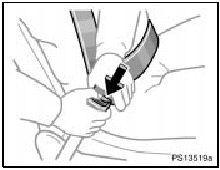
To release the belt, press the buckle release button and allow the belt to retract.
If the belt does not retract smoothly, pull it out and check for kinks or twists. Then make sure it remains untwisted as it retracts.

REAR CENTER SEAT BELT
The rear center seat belt is a 3-point type restraint with 2 buckles. Both seat belt buckles must be correctly located and securely latched for proper operation.
Make sure buckle 1 is securely latched for ready use of the center seat belt.

Two buckles and tabs for rear center seat belt
The two tabs have different shapes to prevent the belt from being buckled in the wrong place.
Buckle 1—Matches the tab with the hooked end.
Buckle 2—Matches the tab with the concave end.
CAUTION.
Make sure the both buckles are correctly located and securely latched.
Failure to properly match the buckle and tab may cause serious injury in case of an accident or a collision.
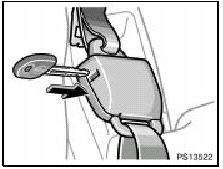
To release the hooked end tab, insert the key into the hole on buckle 1 and allow the belt to retract.

CAUTION.
Do not use the rear center seat belt with either buckle released. Fastening only the shoulder belt or lap belt may cause serious personal injury in case of a sudden braking or a collision.
—Stowing the rear center seat belt

STOWING THE REAR CENTER SEAT BELT TABS
Insert the tabs of the center seat belt into the cover. Make sure the tabs are securely locked in the cover.
Seat belt must be stowed before you fold the seatback.
NOTICE.
Stow the rear center seat belt tabs when not in use.
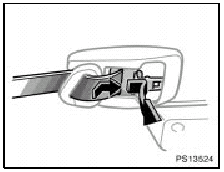
PULLING OUT THE REAR CENTER SEAT BELT TABS
Push the tab and then pull the tabs out from the cover.
—Seat belt comfort guide

The center shoulder belt comfort guide for the rear seat center position will provide added seat belt comfort for children who have outgrown child restraints and for small adults. When the center shoulder belt is inserted through the guide, the comfort guide pulls the belt away from the neck and head of an occupant.
To use the comfort guide, do as follows.

Split seat
Seat belt comfort guide is stored in the pocket on the right side of the left rear seatback.

Non-split seat
Seat belt comfort guide is stored in the pocket behind the rear seatback.

Split seat
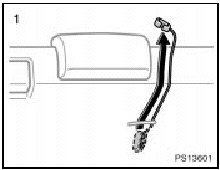
Non-split seat
INSTALLING THE COMFORT GUIDE
1. Pull the comfort guide from the pocket.

2. Pinch the two edges of the shoulder belt for the rear seat center position with your fingers and slide the belt past the slot of the guide as shown above. At this time, the elastic cord must be behind the seat belt.
CAUTION.
Make sure the belt is not twisted and that it lies flat. The elastic cord must be behind the belt and the guide must be on the front.

3. Buckle, position and release the seat belt. (For wearing the seat belt, see “—Fastening front and rear seat belts”).
CAUTION.
Always make sure the shoulder belt is positioned across the center of the shoulder. The belt should be kept away from the neck, and should not fall off the shoulder. Failure to observe these precautions could reduce the effectiveness of the seat belt in an accident, causing death or serious injury.

Split seat
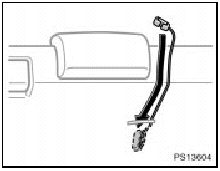
Non-split seat
REMOVING AND STORING THE COMFORT GUIDE
Pinch the two edges of the seat belt together so that you can slide them out of the guide. Store the guide with the elastic cord into the pocket.
CAUTION.
To reduce the chance of injury in case of an accident or a sudden stop while driving, remove and store the comfort guide in its pocket when it is not in use.
—Seat belt extender
If your seat belts cannot be fastened securely because they are not long enough, a personalized seat belt extender is available from your Toyota dealer free of charge.
Please contact your local Toyota dealer so that the dealer can order the proper required length for the extender. Bring the heaviest coat you expect to wear for proper measurement and selection of length.
Additional ordering information is available at your Toyota dealer.
CAUTION.
When using the seat belt extender, observe the following precautions.
Failure to follow these instructions could reduce the effectiveness of the seat belt restraint system in case of an accident, increasing the chance of personal injury.
Remember that the extender provided for you may not be safe when used on a different vehicle, for another person, or at a different seating position than the one originally intended.
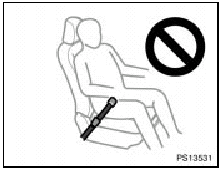
If the seat belt extender has been connected to the driver’s seat belt buckle without wearing the seat belt when using the extender in the driver’s seat, the SRS driver’s airbag system will judge that the driver wears the seat belt even if not wearing it. In this case, the driver’s airbag may not activate correctly, causing death or serious injury in the event of collision. Be sure to wear the seat belt with the seat belt extender.
Make sure the “AIRBAG ON” indicator light is illuminated when using the seat belt extender for the front passenger seat. If the “AIRBAG OFF” indicator light is illuminated, disconnect the extender tongue from the seat belt buckle, then reconnect the seat belt.
Reconnect the seat belt extender after making sure the “AIRBAG ON” indicator light is illuminated. If you use the seat belt extender while the “AIRBAG OFF” indicator light is illuminated, the front passenger airbag and side airbag on the front passenger side may not activate correctly, causing death or serious injury in the event of collision.
Be sure to wear the seat belt without the seat belt extender if you can fasten the seat belt without the extender.
Do not use the seat belt extender when installing a child restraint system on the front or rear passenger seat. If installing a child restraint system with the seat belt extender connected to the seat belt, the seat belt will not securely hold the child restraint system, which could cause death or serious injury to the child or other passengers in the event of collision.
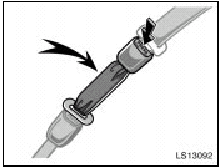
To connect the extender to the seat belt, insert the tab into the seat belt buckle so that the “PRESS” signs on the buckle release buttons of the extender and the seat belt are both facing outward as shown.
You will hear a click when the tab locks into the buckle.
When releasing the seat belt, press on the buckle release button on the extender, not on the seat belt. This helps prevent damage to the vehicle interior and extender itself.
As far as the seat belt extender on the front passenger side is concerned, do not fail to disconnect the extender from the seat belt after the above operation in order to activate the front passenger airbag correctly when getting into the vehicle next time.
When not in use, remove the extender and store in the vehicle for future use.
CAUTION.
After inserting the tab, make sure the tab and buckle are locked and that the lap and shoulder portions of the belt and the seat belt extender are not twisted.
Do not insert coins, clips, etc. in the buckle as this may prevent you from properly latching the tab and buckle.
If the seat belt does not function normally, immediately contact your Toyota dealer. Do not use the seat until the seat belt is fixed, because it cannot protect an adult occupant or your child from death or serious injury.
—Seat belt pretensioners

The driver and front passenger seat belt pretensioners are designed to be activated in response to a severe frontal impact.
When the sensor detects a severe frontal impact, the front seat belts are quickly drawn back by the retractors so that the belts snugly restrain the occupants.
The front passenger’s seat belt pretensioner will not activate if no passenger is detected in the front passenger seat by the front passenger occupant classification system. However, the front passenger’s seat belt pretensioner may activate if luggage is put on the seat, or the seat belt is buckled up regardless of the presence of an occupant in the seat. (As for the front passenger occupant classification system, see “Front passenger occupant classification system”).
The seat belt pretensioners and SRS airbags may not operate together in all collisions.
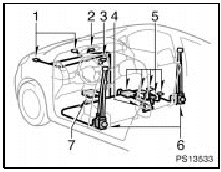
The seat belt pretensioner system consists mainly of the following components and their locations are shown in the illustration.
1. Front airbag sensors
2. SRS warning light
3. “AIRBAG ON” and “AIRBAG OFF” indicator lights
4. Front passenger’s seat belt buckle switch
5. Front passenger occupant classification system (ECU and sensors)
6. Seat belt pretensioner assemblies
7. Airbag sensor assembly
The seat belt pretensioners are controlled by the airbag sensor assembly. The airbag sensor assembly consists of a safing sensor and airbag sensor.
When the seat belt pretensioners are activated, an operating noise may be heard and a small amount of non-toxic gas may be released. This does not indicate that a fire is occurring. This gas is normally harmless.
Once the seat belt pretensioners have been activated, the seat belt retractors remain locked.
CAUTION.
Do not modify, remove, strike or open the seat belt pretensioner assemblies, airbag sensor or surrounding area or wiring. Failure to follow these instruction may prevent the seat belt pretensioners from activating correctly, cause sudden operation of the system or disable the system, which could result in death or serious injury. Consult your Toyota dealer about any repair and modification.
NOTICE.
Do not perform any of the following changes without consulting your Toyota dealer. Such changes can interfere with proper operation of the seat belt pretensioners in some cases.
Installation of electronic devices such as a mobile two-way radio, cassette tape player or compact disc player Repairs on or near the front seat belt retractor assemblies Modification of the suspension system Modification of the front end structure Attachment of a grille guard (bull bar, kangaroo bar, etc.), snowplow, winches or any other equipment to the front end Repairs made on or near the front fenders, front end structure or console

This indicator comes on when the ignition key is turned to the “ON” position.
It goes off after about 6 seconds. This means the seat belt pretensioners are operating properly.
This warning light system monitors the airbag sensor assembly, front airbag sensors, side and curtain shield airbag sensors, curtain shield airbag sensors, driver’s seat position sensor, driver’s seat belt buckle switch, front passenger occupant classification system, “AIRBAG ON” indicator light, “AIRBAG OFF” indicator light, front passenger’s seat belt buckle switch, seat belt pretensioner assemblies, inflators, interconnecting wiring and power sources. (For details, see “Service reminder indicators and warning buzzers”).
If any of the following conditions occurs, this indicates a malfunction of the airbags or seat belt pretensioners. Contact your Toyota dealer as soon as possible.
The light does not come on when the ignition key is turned to the “ON” position or remains on for more than 6 seconds or flashes.
The light comes on or starts flashing while driving.
If any seat belt does not retract or can not be pulled out due to a malfunction or activation of the relevant seat belt pretensioner.
The seat belt pretensioner assembly or surrounding area has been damaged.

In the following cases, contact your Toyota dealer as soon as possible: The front part of the vehicle (shaded in the illustration) was involved in an accident that was not severe enough to cause the seat belt pretensioners to operate.
Either seat belt pretensioner assembly or surrounding area is scratched, cracked, or otherwise damaged.
 Head restraints
Head restraints
Front seat
Rear seat (split seat)
Rear seat (non-split seat)
For your safety and comfort, adjust the head restraint before driving.
To raise: Pull it up.
To lower: Push it down whil ...
 SRS driver and front passenger airbags
SRS driver and front passenger airbags
The SRS (Supplemental Restraint System) airbags are designed to provide further
protection for the driver and front passenger in addition to the primary safety
protection provided by the seat be ...
See also:
Front door outer panel (CUT): Hatchback 5 Door
REPLACEMENT
REMOVAL
INSTALLATION
Temporarily install the new parts and measure each part of the new parts in accordance
with the body dimension diagram. (See the body dimension diagram) Inspe ...
Power windows
The windows can be operated with the switch on each side door.
The ignition key must be in the “ON” position.
Key off operation: The driver’s window works for about 45 seconds even after
...
Opening and closing the windows
Power windows
The power windows can be opened and closed using the switches.
Operating the switch moves the windows as follows:
Closing
Opening
One-touch opening (driver’s window only) ...
